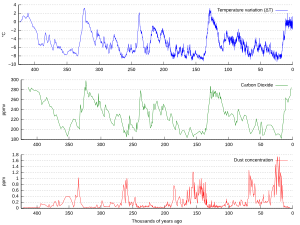Orbital forcing


Orbital forcing is the effect on climate of slow changes in the tilt of the Earth's axis and shape of the orbit (see Milankovitch cycles).
These orbital changes alter the amount of sunlight reaching the Earth by up to 25% at mid-latitudes. That has a huge effect. The term "forcing" is a physical process which definitely affects the Earth's climate.[2]
This mechanism is believed to be responsible for the timing of the ice age cycles. The timing of past glacial periods coincides very well with the predictions of the Milankovitch theory, and these effects can be calculated into the future.
Note in the graphic the strong 100,000 year periodicity of the cycles, and the striking asymmetry of the curves. Ice ages deepen by progressive steps, but the recovery to interglacial conditions occurs in one big step.
References
[change | change source]- ↑ Hays, J. D.; Imbrie, John; Shackleton, N. J. (1976). "Variations in the Earth's orbit: pacemaker of the ice ages". Science. 194 (4270): 1121–1132. Bibcode:1976Sci...194.1121H. doi:10.1126/science.194.4270.1121. PMID 17790893. S2CID 667291.
- ↑ Milankovitch, Milutin 1998. [1941]. Canon of insolation and the Ice Age problem. Belgrade: Zavod za Udz̆benike i Nastavna Sredstva. ISBN 8617066199
